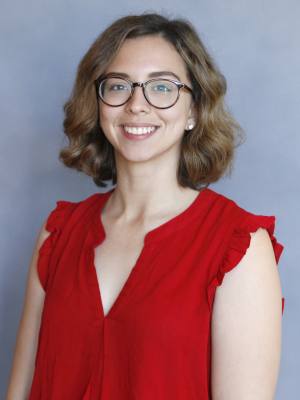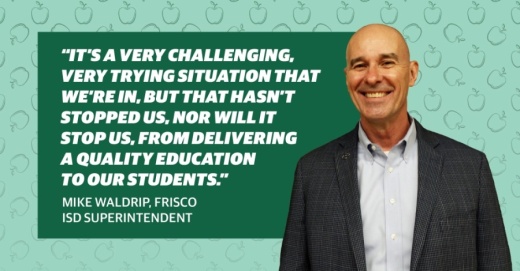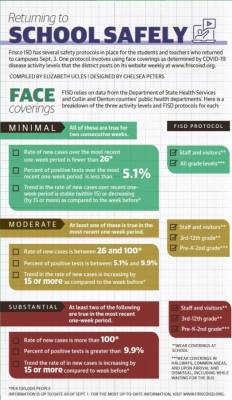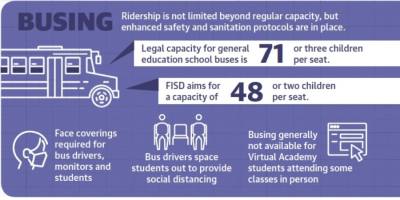Months of work have gone into making in-person learning safe during the coronavirus pandemic. Over the summer, FISD families decided whether their students would return to school or continue learning remotely.
FISD data shows 53.6% of high school seniors are returning to in-person school learning—the highest percentage among all grades. The grades with the lowest percentage returning to school is prekindergarten at 34.8%, followed by third grade at 39.9%.
Among individual schools, more than 75% of Wakeland High School students opted to return to class in person, per FISD data. At Talley Elementary School, nearly 89% of students opted to continue learning virtually. The district will now navigate two learning environments while serving more than 60,000 students.
“We’ve rewritten our curriculum,” Superintendent Mike Waldrip said. “We’ve spent countless weeks and months working on different protocols to deal with all the health concerns and the distancing. I feel very confident that we’re prepared to start school.”
Addressing positive cases
Preparing to start school also involves laying out procedures for positive COVID-19 cases if they arise.
“The kids that are in person, there will be times when they’ll have to go back and do some virtual learning,” Waldrip said. “It’s probably a given until something happens with regard to a vaccine or treatment for this disease.”
This is the concern of Dawn Sample whose son returned to Allen Elementary School in person.
“I’d like to go back to work full-time now, and I can’t manage home-schooling and working full-time,” said Sample, whose son is in first grade.
The district is limiting intermingling on campuses as much as possible so “close contact reviews” can be completed with each confirmed case as well as for anyone displaying symptoms consistent with COVID-19.
This review process will determine which staff members and students came into close contact with an infected individual. Those who had contact will be notified and asked to quarantine for 14 days.
Whether the quarantine is limited to a small group or results in closure of a campus depends on several factors.
For instance, increased absences among staff and students could result in a closure. A closure could also be warranted if the needs of special education students are compromised.
FISD may close a campus for up to five days to complete notifications and quarantine procedures, but Waldrip said the district will try to minimize the length of closures to maintain instructional continuity for students.
“There may be times when we don’t even have to close the school,” he said.
Staffing
This school year, FISD staff are assigned in different ways due to the two learning environments. Some teachers in the online learning track, for example, have students from more than one campus in their classes.
“This was necessary in order to effectively allocate staffing and ensure courses had sufficient enrollment to be offered in a virtual setting,” said Pamela Linton, FISD chief human resources officer, in an email.
While some districts across the country have seen a shortage of teachers due to COVID-19 concerns, Frisco ISD reported that its turnover has been similar to that of previous years.
“What has been different compared to past trends is that we have noted more retirements and resignations closer to the start of the school year as opposed to previous years,” Linton said.
FISD also reported that there is a sufficient number of substitute teachers available.
In years past, FISD has had difficulty maintaining a healthy pool of substitutes. In August 2019, the district began contracting with a substitute sourcing company, which improved FISD’s substitute pool that school year. The district has contracted with the same company for this school year.
Student experience
One of the biggest challenges during the pandemic is the limits on student interaction.
Most full-school events in the district are occurring virtually. Activities held in person, such as marching band and athletics practices, must maintain social distancing and uphold other requirements outlined by the district, the TEA and the University Interscholastic League.
Opening night for high school football is scheduled for Sept. 24. Stadium capacity will be reduced to allow for social distancing, and most sporting events will be streamed live online, according to FISD.
That in-person interaction, whether it is at a sporting event or in the hallway, is important to a student’s development, identity and school experience, said Ranita Cheruvu, senior lecturer at the University of North Texas College of Education.
“It’s probably part of why people want kids in school,” Cheruvu said. “School is a huge part of how kids connect with their peers.”
That peer interaction is one reason that parent Amy Harmon said she opted to send her second-grader back to class in person this fall. She said virtual learning last spring took a toll on her son’s mental health.
“He went from being a great sleeper to waking up 2-3 times a night with bad dreams and going to bed with anxiety,” she said in an email.
Mental health is also a concern for parent Samia Akhter Shamim, whose three elementary-age children are in the Virtual Academy at Vaughn Elementary School.
“Children definitely need to socialize and be taught face-to-face, but safety is my family’s top priority at the moment,” Akhter Shamim said.
Stephanie Cook, FISD managing director of guidance and counseling, said students’ mental well-being is a priority now more than ever.
The district uses a curriculum tailored to each grade level. The curriculum addresses “wellness and personal development as students continue to cope with loss and change and adapt to situations beyond their control,” Cook said in an email.
In FISD, elementary school teachers lead daily class meetings to foster student connections, Cook said. Weekly activities are also a part of the middle and high school experience, she said.
Whether students continue in virtual learning or return to schools, Waldrip said he believes the work done behind the scenes by district leaders to support students will pay off.
“It’s a very challenging, very trying situation that we’re in, but that hasn’t stopped us, nor will it stop us, from delivering a quality education to our students,” he said.








